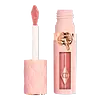Anastasia Beverly Hills Lip Gloss Versus Charlotte Tilbury Pillow Talk Big Lip Plumpgasm Plumping Lip Gloss
What's inside
What's inside
 Key Ingredients
Key Ingredients

 Benefits
Benefits

 Concerns
Concerns

 Ingredients Side-by-side
Ingredients Side-by-side

Polybutene
Tridecyl Trimellitate
EmollientHydrogenated Polyisobutene
EmollientOctyldodecyl Stearoyl Stearate
EmollientSilica
AbrasivePentaerythrityl Tetraisostearate
EmollientPolyglyceryl-2 Diisostearate
EmulsifyingSilica Dimethyl Silylate
EmollientDisteardimonium Hectorite
StabilisingEthyl Vanillin
MaskingPropylene Carbonate
SolventAluminum Hydroxide
EmollientPentaerythrityl Tetra-Di-T-Butyl Hydroxyhydrocinnamate
AntioxidantDicalcium Phosphate
AbrasiveMica
Cosmetic ColorantCalcium Titanium Borosilicate
AbrasiveTocopherol
AntioxidantTin Oxide
AbrasiveCI 77891
Cosmetic ColorantCI 77492
Cosmetic ColorantCI 42090
Cosmetic ColorantCI 15850
Cosmetic ColorantCI 77742
Cosmetic ColorantPolybutene, Tridecyl Trimellitate, Hydrogenated Polyisobutene, Octyldodecyl Stearoyl Stearate, Silica, Pentaerythrityl Tetraisostearate, Polyglyceryl-2 Diisostearate, Silica Dimethyl Silylate, Disteardimonium Hectorite, Ethyl Vanillin, Propylene Carbonate, Aluminum Hydroxide, Pentaerythrityl Tetra-Di-T-Butyl Hydroxyhydrocinnamate, Dicalcium Phosphate, Mica, Calcium Titanium Borosilicate, Tocopherol, Tin Oxide, CI 77891, CI 77492, CI 42090, CI 15850, CI 77742
Polybutene
Hydrogenated Polydecene
EmollientCaprylic/Capric Triglyceride
MaskingHydrogenated Didecene
Skin ConditioningDiisostearyl Malate
EmollientHydrogenated Styrene/Isoprene Copolymer
Silica Silylate
EmollientSynthetic Fluorphlogopite
Dicalcium Phosphate
AbrasiveMethyl Diisopropyl Propionamide
MaskingHelianthus Annuus Seed Oil
EmollientEthylhexyl Palmitate
EmollientEthyl Vanillin
MaskingTocopheryl Acetate
AntioxidantPentaerythrityl Tetra-Di-T-Butyl Hydroxyhydrocinnamate
AntioxidantCaprylyl Glycol
Emollient1,2-Hexanediol
Skin ConditioningVanillyl Butyl Ether
MaskingLupinus Albus Seed Extract
Skin ConditioningCapsicum Frutescens Resin
CleansingSilica Dimethyl Silylate
EmollientTocopherol
AntioxidantButylene Glycol
HumectantCanola Oil
EmollientPhenoxyethanol
PreservativeGlyceryl Stearates
EmollientSodium Hyaluronate
HumectantAscorbyl Palmitate
AntioxidantHexylene Glycol
EmulsifyingCI 77891
Cosmetic ColorantIron Oxides
CI 42090
Cosmetic ColorantCI 15850
Cosmetic ColorantPolybutene, Hydrogenated Polydecene, Caprylic/Capric Triglyceride, Hydrogenated Didecene, Diisostearyl Malate, Hydrogenated Styrene/Isoprene Copolymer, Silica Silylate, Synthetic Fluorphlogopite, Dicalcium Phosphate, Methyl Diisopropyl Propionamide, Helianthus Annuus Seed Oil, Ethylhexyl Palmitate, Ethyl Vanillin, Tocopheryl Acetate, Pentaerythrityl Tetra-Di-T-Butyl Hydroxyhydrocinnamate, Caprylyl Glycol, 1,2-Hexanediol, Vanillyl Butyl Ether, Lupinus Albus Seed Extract, Capsicum Frutescens Resin, Silica Dimethyl Silylate, Tocopherol, Butylene Glycol, Canola Oil, Phenoxyethanol, Glyceryl Stearates, Sodium Hyaluronate, Ascorbyl Palmitate, Hexylene Glycol, CI 77891, Iron Oxides, CI 42090, CI 15850
Ingredients Explained
These ingredients are found in both products.
Ingredients higher up in an ingredient list are typically present in a larger amount.
Ci 15850 is the pigment color red. It is an azo dye and created synthetically.
Azo dyes need to be thoroughly purified before use. This allows them to be more stable and longer-lasting.
This ingredient is common in foundations, lipsticks, and blushes. This color is described as brown/orangey red.
It has many secondary names such as Red 6 and Red 7. According to a manufacturer, Red 6 usually contains aluminum.
Learn more about CI 15850Ci 42090 is a synthetic dye created from petroleum. It is used to give a bright blue color to cosmetics, medicine, and food.
Ci 77891 is a white pigment from Titanium dioxide. It is naturally found in minerals such as rutile and ilmenite.
It's main function is to add a white color to cosmetics. It can also be mixed with other colors to create different shades.
Ci 77891 is commonly found in sunscreens due to its ability to block UV rays.
Learn more about CI 77891Dicalcium Phosphate is an exfoliant.
We don't have a description for Ethyl Vanillin yet.
Pentaerythrityl Tetra-Di-T-Butyl Hydroxyhydrocinnamate (long name, huh?) is a synthetic antioxidant.
It is used to help stabilize other antioxidants or prevent the color from changing in a product.
As an antioxidant, it helps fight free-radical molecules. Free-radical molecules are capable of damaging our cells and other genetic material. Thus, antioxidants may reduce the signs of aging.
This ingredient is oil-soluble.
Learn more about Pentaerythrityl Tetra-Di-T-Butyl HydroxyhydrocinnamatePolybutene is used to help control the viscosity of a product. This just means it helps adjusts the texture.
It is a polymer and does not get absorbed into the skin due to its large size.
Studies found this ingredient did not irritate skin in concentrations below 15%.
Learn more about PolybuteneThis silica is mainly used to thicken oils and suspend particles in oils. It is not water soluble.
According to the manufacturer, it:
The manufacturer also claims this ingredient to be useful in makeup.
In lipstick formulations, this ingredient improves color payoff, reduces pigment settling, and reduces oil bleeding. This ingredient also improves the grip of powder products such as dry shampoos.
Learn more about Silica Dimethyl SilylateTocopherol (also known as Vitamin E) is a common antioxidant used to help protect the skin from free-radicals and strengthen the skin barrier. It's also fat soluble - this means our skin is great at absorbing it.
Vitamin E also helps keep your natural skin lipids healthy. Your lipid skin barrier naturally consists of lipids, ceramides, and fatty acids. Vitamin E offers extra protection for your skin’s lipid barrier, keeping your skin healthy and nourished.
Another benefit is a bit of UV protection. Vitamin E helps reduce the damage caused by UVB rays. (It should not replace your sunscreen). Combining it with Vitamin C can decrease sunburned cells and hyperpigmentation after UV exposure.
You might have noticed Vitamin E + C often paired together. This is because it is great at stabilizing Vitamin C. Using the two together helps increase the effectiveness of both ingredients.
There are often claims that Vitamin E can reduce/prevent scarring, but these claims haven't been confirmed by scientific research.
Learn more about Tocopherol